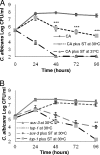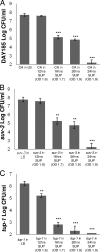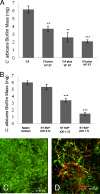Interaction of Candida albicans with an intestinal pathogen, Salmonella enterica serovar Typhimurium
- PMID: 19329669
- PMCID: PMC2681611
- DOI: 10.1128/EC.00016-09
Interaction of Candida albicans with an intestinal pathogen, Salmonella enterica serovar Typhimurium
Abstract
Candida albicans is an opportunistic human fungal pathogen that normally resides in the gastrointestinal tract and on the skin as a commensal but can cause life-threatening invasive disease. Salmonella enterica serovar Typhimurium is a gram-negative bacterial pathogen that causes a significant amount of gastrointestinal infection in humans. Both of these organisms are also pathogenic to the nematode Caenorhabditis elegans, causing a persistent gut infection leading to worm death. In the present study, we used a previously developed C. elegans polymicrobial infection model to assess the interactions between S. Typhimurium and C. albicans. We observed that when C. elegans is infected with C. albicans and serovar Typhimurium, C. albicans filamentation is inhibited. The inhibition of C. albicans filamentation by S. Typhimurium in C. elegans appeared to be mediated by a secretary molecule, since filter-sterilized bacterial supernatant was able to inhibit C. albicans filamentation. In vitro coculture assays under planktonic conditions showed that S. Typhimurium reduces the viability of C. albicans, with greater effects seen at 37 degrees C than at 30 degrees C. Interestingly, S. Typhimurium reduces the viability of both yeast and filamentous forms of C. albicans, but the killing appeared more rapid for the filamentous cells. The antagonistic interaction was also observed in a C. albicans biofilm environment. This study describes the interaction between two diverse human pathogens that reside within the gastrointestinal tract and shows that the prokaryote, S. Typhimurium, reduces the viability of the eukaryote, C. albicans. Identifying the molecular mechanisms of this interaction may provide important insights into microbial pathogenesis.
Figures





References
-
- Aballay, A., P. Yorgey, and F. M. Ausubel. 2000. Salmonella typhimurium proliferates and establishes a persistent infection in the intestine of Caenorhabditis elegans. Curr. Biol. 101539-1542. - PubMed
-
- Ahmer, B. M. 2004. Cell-to-cell signalling in Escherichia coli and Salmonella enterica. Mol. Microbiol. 52933-945. - PubMed
-
- Braun, B. R., and A. D. Johnson. 1997. Control of filament formation in Candida albicans by the transcriptional repressor TUP1. Science 277105-109. - PubMed
Publication types
MeSH terms
Grants and funding
LinkOut - more resources
Full Text Sources
Other Literature Sources

